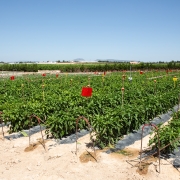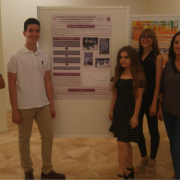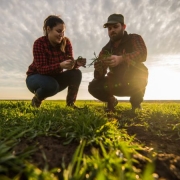Posts
LIFE AgRemSO3il at the 6th IDIES congress
Students from IES Juan Carlos I (Murcia) presented the communication “Application of ozonation technique for the removal of thiamethoxam residues in farm soils” in the 6th edition of IDIES congress, held at Auditorio Víctor Villegas (Murcia) on 25thJune. The work was tutored by J. Fenoll (LIFE-AgRemSO3il, IMIDA), M. Aliste (IMIDA) and A.A. Sánchez (IES Juan Carlos I).
IDIES is an educational project of initiation to research focuses in secondary school students. The main objective is that students learn what is research and how must be performed, collaborating with researchers of different institutions. After a training period, students will disseminate their results (via oral and poster communication) in IDIES congress. At the moment it participates 10 secondary schools (from Mazarrón, Murcia, Alcantarilla, San Javier, Molina de Segura, Archena and Lorca) and 5 institutions: 2 research centers (CEBAS-CSIS, IMIDA) and 3 universities (UMU-Murcia, UPCT-Cartagena and UMH-Elche).

Czech agriculture goes digital as science meets with farmers
Close collaboration between scientists, researchers and farmers has helped agriculture in the Czech Republic to take significant digital steps and increase its competitiveness, analysts told EURACTIV Czech Republic.
An increasing number of Czech farmers have embraced the idea of “producing more with less input” through the application of technology-based precision farming practices.
There are already about 250 milking robots in the Czech Republic. There are also automatic floor cleaners in cowsheds, which suck up the slurry and remove it. This progress is also visible in the Czech fields, with tractors connected to the Internet.
“Czech farmers are the world leaders in using these technologies. Approximately three-quarters of Czech farmers use some of the precision farming systems,” Veronika Hlaváčková, director of the Institute for Agriculture Education, said.
Precise equals ecological?
Analysts suggest that modern technologies will inevitably prevail in the agriculture sector and have a multidimensional role to play in reducing the use of pesticides and bureaucracy for audit authorities.
“We can dramatically reduce inputs thanks to robotization, especially the consumption of pesticides and water,” Vojtěch Kotecký, an environment protection expert, said, adding that robots apply much fewer herbicides and more accurately compared to conventional spraying.
“Although the Czech herbicide consumption fell by 19% between 2009 and 2016, robotics could bring result in even more dramatic drop,” Kotecký said.
The digitisation of the EU farming sector has become a priority for EU policymakers. The European Commission recently submitted to the EU member states a draft declaration titled “A smart and sustainable digital future for European agriculture and rural areas”.
According to the document, EU member states recognise the “urgency” to speed up the introduction of new technologies in order to address increasing challenges related to the environment, economy and society.
Scientists and farmers
The digital revolution in agriculture would never have been possible without research, development and its subsequent implementation. However, linking scientists and farmers is not an easy task.
“So far, the connection between the research sphere and agricultural practice has not been ensured. A number of research projects concerned areas that have not been very useful in practice or on the contrary farmers have been unable to get to useful research results,” Hlaváčková explained.
Almost three years ago, a Technology Platform for Agriculture was established in the Czech Republic, and Veronika Hlaváčková has been the main coordinator.
Thanks to the cooperation and direct communication between farmers and scientists, Czech agriculture is gradually being modernised and refined, she said.
“Over decades, Czech researchers in collaboration with major agricultural machinery manufacturers and Czech farmers have been the creators of many solutions such as sensors, soil probes and work algorithms that help to maintain or improve soil quality. And not just in the Czech Republic,” Hlaváčková said.
Modern technology in agriculture does not only mean the replacement of forks with robots and drones. New ways of growing plants are also being explored so that a crop grows while costs decrease.
The new technology is being tested first with pilot companies, so-called demo-farms, before engaging in the normal agricultural activity. One of them is Bureš Farm where the cultivation of supporting crops is tested.
“A total of 100 hectares of winter wheat are sown on demofarm and surrounding farms with a slug as an auxiliary crop. The stands are being closely monitored and the data are used to verify the research outputs,” said Jindřich Šmöger.
“In agriculture, the result is not visible from one day to another; it is a long-distance run. It is necessary to introduce new technologies in practice, first on smaller areas, then on larger and then of course in different conditions,” Šmöger added.
The potential
Miloslav Klas, the Director of the Agricultural Society Chrášťany, said there was great demand for precision agriculture.
“It is a dynamically developing field where many research teams, both foreign and domestic, operate. Precise farming methods and procedures begin to standardise and are finally prepared in such a way that they can be used effectively for their benefit by a large part of farms in the Czech Republic,” Klas said.
According to him, the development of precision agriculture is also boosted by the fact that most Czech agricultural holdings are led by university level experts.
“There is a new technological stage of agricultural production development ahead of us. It will bring many new opportunities, which would have been difficult to achieve before,” Klas concluded.
[Edited by Sarantis Michalopoulos, Sam Morgan]
Young people and women in EU farming
The EU farming sector is faced with an ageing population. In 2016 only 11% of farm managers in the EU were young farmers under the age of 40 years, according to Eurostat.
According to European Parliament surveys, even though EU assistance has been available to young farmers for more than three decades, the ‘young farmer problem’ seems to remain.
The European Commission’s proposal for the post-2020 Common Agricultural Policy (CAP) has set nine objectives, one of which is generational renewal. The CAP budget will play a key role in achieving these goals but its future level is uncertain because member states are still discussing EU budget priorities for the period 2021-2027.
Another issue is the role of women in EU agriculture. Eurostat data from 2013 shows that on average around 30% of farms across the EU are managed by a woman. The differences among member states are remarkable, ranging from just over 5% in the Netherlands to around 47% in Lithuania.
In February 2017, the European Parliament’s Agriculture Committee and Women’s Committee approved a report calling for an enhanced role of women in EU farming.
EU lawmakers believe that women have a key role in helping to revive rural areas as well as avoiding further urbanisation.
“This report highlights the multifunctional role of a rural woman – as a mother, a homemaker, a worker, an educator, a manager of a family farm, a guardian of culture, heritage and tradition,” Croatian MEP Marjiana Petir told EURACTIV.com.
Similarly, a global study carried out by Corteva Agriscience found that discrimination against women in the farming sector is still widespread.
“Empowering women could help revive rural areas and meet rising food demand,” the report said.




